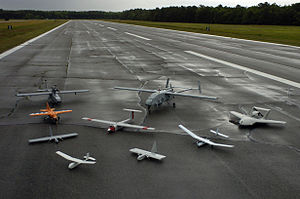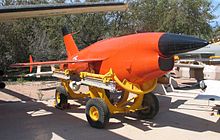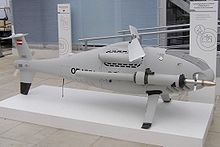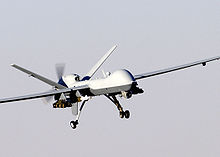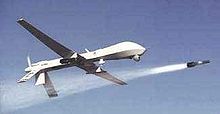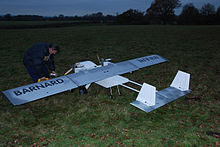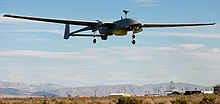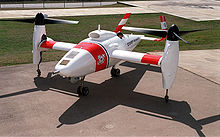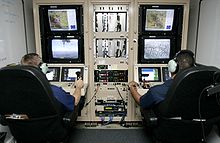- Unmanned aerial vehicle
-
"UAV" redirects here. For the entertainment company, see UAV Corp.. For the veterans' organization, see Ukrainian American Veterans.
An unmanned aerial vehicle (UAV), also known as a unmanned aircraft system (UAS), remotely piloted aircraft (RPA) or unmanned aircraft, is a machine which functions either by the remote control of a navigator or pilot (called a Combat Systems Officer on UCAVs) or autonomously, that is, as a self-directing entity. Their largest use is within military applications. To distinguish UAVs from missiles, a UAV is defined as a "powered, aerial vehicle that does not carry a human operator, uses aerodynamic forces to provide vehicle lift, can fly autonomously or be piloted remotely, can be expendable or recoverable, and can carry a lethal or nonlethal payload".[1] Therefore, cruise missiles are not considered UAVs, because, like many other guided missiles, the vehicle itself is a weapon that is not reused, even though it is also unmanned and in some cases remotely guided.
There are a wide variety of UAV shapes, sizes, configurations, and characteristics. Historically, UAVs were simple drones[2] (remotely piloted aircraft), but autonomous control is increasingly being employed in UAVs. UAVs come in two varieties: some are controlled from a remote location (which may even be many thousands of kilometers away, on another continent), and others fly autonomously based on pre-programmed flight plans using more complex dynamic automation systems.
Currently, military UAVs perform reconnaissance as well as attack missions.[3] While many successful drone attacks on militants have been reported, they have a reputation of being prone to collateral damage and/or erroneous targeting, as with many other weapon types.[2] UAVs are also used in a small but growing number of civil applications, such as firefighting or nonmilitary security work, such as surveillance of pipelines. UAVs are often preferred for missions that are too "dull, dirty, or dangerous" for manned aircraft.
Contents
History
The earliest attempt at a powered unmanned aerial vehicle was A. M. Low's "Aerial Target" of 1916.[4] Nikola Tesla described a fleet of unmanned aerial combat vehicles in 1915.[5] A number of remote-controlled airplane advances followed, including the Hewitt-Sperry Automatic Airplane, during and after World War I, including the first scale RPV (Remote Piloted Vehicle), developed by the film star and model airplane enthusiast Reginald Denny in 1935.[4] More were made in the technology rush during World War II; these were used both to train antiaircraft gunners and to fly attack missions. Jet engines were applied after World War II, in such types as the Teledyne Ryan Firebee I of 1951, while companies like Beechcraft also got in the game with their Model 1001 for the United States Navy in 1955.[4] Nevertheless, they were more than little remote-controlled airplanes until the Vietnam Era.
The birth of U.S. UAVs (called RPVs at the time) began in 1959 when United States Air Force (USAF) officers, concerned about losing pilots over hostile territory, began planning for the use of unmanned flights.[6] This plan became intensified when Francis Gary Powers and his "secret" U-2 were shot down over the Soviet Union in 1960. Within days, the highly classified UAV program was launched under the code name of "Red Wagon."[7] The August 2 and August 4, 1964, clash in the Tonkin Gulf between naval units of the U.S. and North Vietnamese Navy initiated America's highly classified UAVs into their first combat missions of the Vietnam War.[8] When the "Red Chinese"[9] showed photographs of downed U.S. UAVs via Wide World Photos,[10] the official U.S. response was, "no comment."
Only on February 26, 1973, during testimony before the United States House Committee on Appropriations, did the U.S. military officially confirm that they had been utilizing UAVs in Southeast Asia (Vietnam).[11] While over 5,000 U.S. airmen had been killed and over 1,000 more were either missing in action (MIA), or captured (prisoners of war/POW); the USAF 100th Strategic Reconnaissance Wing had flown approximately 3,435 UAV missions during the war,[12] at a cost of about 554 UAVs lost to all causes. In the words of USAF General George S. Brown, Commander, Air Force Systems Command in 1972, "The only reason we need (UAVs) is that we don't want to needlessly expend the man in the cockpit."[13] Later that same year, General John C. Meyer, Commander in Chief, Strategic Air Command, stated, "we let the drone do the high-risk flying ... the loss rate is high, but we are willing to risk more of them ... they save lives!"[13]
During the 1973 Yom Kippur War, Syrian missile batteries in Lebanon caused heavy damage to Israeli fighter jets. As a result, Israel developed the first modern UAV. Israel pioneered the use of UAVs for real-time surveillance, electronic warfare and decoys.[14] [15] [16] The images and radar decoying provided by these UAVs helped Israel to completely neutralize the Syrian air defenses at the start of the 1982 Lebanon War, resulting in no pilots downed.[17]
With the maturing and miniaturization of applicable technologies as seen in the 1980s and 1990s, interest in UAVs grew within the higher echelons of the U.S. military. In the 90s the U.S. Department of Defense began to buy UAVs from Israel. The Navy bought the Pioneer UAV, which is still in use. Many of these Israeli and newly developed U.S. UAVs were used in the 1991 Gulf War. UAVs were seen to offer the possibility of cheaper, more capable fighting machines that could be used without risk to aircrews. Initial generations were primarily surveillance aircraft, but some were armed (such as the General Atomics MQ-1 Predator, which utilized AGM-114 Hellfire air-to-ground missiles). An armed UAV is known as an unmanned combat air vehicle (UCAV).
As a tool for search and rescue, UAVs can help find humans lost in the wilderness, trapped in collapsed buildings, or adrift at sea.
FAA designation
In the United States, the United States Navy and shortly after the Federal Aviation Administration has adopted the name unmanned aircraft (UA) to describe aircraft systems without the flight crew on board. More common names include: UAV, drone, remotely piloted vehicle (RPV), remotely operated aircraft (ROA), and for those "limited-size" (as defined by the FAI) unmanned aircraft flown in the USA's National Airspace System, flown solely for recreation and sport purposes such as models and radio control (R/Cs), which are generally flown under the voluntary safety standards of the Academy of Model Aeronautics,[18] the United States' national aeromodeling organization.
The term unmanned aircraft system (UAS) emphasizes the importance of other elements beyond an aircraft itself. A typical UAS consists of the:
- unmanned aircraft (UA)
- control system, such as Ground Control Station (GCS)
- control link, a specialized datalink
- other related support equipment.
For example, the RQ-7 Shadow UAS consists of four UAs, two GCSes, one portable GCS, one Launcher, two Ground Data Terminals (GDTs), one portable GDT, and one Remote Video Terminal. Certain military units are also fielded with a maintenance support vehicle.
Because of this systemic approach UAS have been not included in the United States Munitions List Category VIII – Aircraft and Associated Equipment. Vice versa, the “Unmanned Aerial Vehicle Systems” are clearly mentioned at paragraph 121-16 Missile Technology Control Regime Annex of the United States Munitions List. More precisely, the Missile Technology Control Regime Annex levels rocket and unmanned aerial vehicle systems together.
The term UAS was since adopted by the United States Department of Defense (DoD) and the British Civil Aviation Authority (CAA).
The term used previously for unmanned aircraft system was unmanned-aircraft vehicle system (UAVS).
Classification
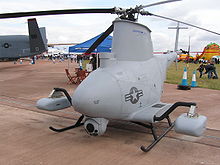 Although most UAVs are fixed-wing aircraft, rotorcraft designs (i.e., RUAVs) such as this MQ-8B Fire Scout are also used.
Although most UAVs are fixed-wing aircraft, rotorcraft designs (i.e., RUAVs) such as this MQ-8B Fire Scout are also used.
UAVs typically fall into one of six functional categories (although multi-role airframe platforms are becoming more prevalent):
- Target and decoy – providing ground and aerial gunnery a target that simulates an enemy aircraft or missile
- Reconnaissance – providing battlefield intelligence
- Combat – providing attack capability for high-risk missions (see Unmanned combat air vehicle)
- Logistics – UAVs specifically designed for cargo and logistics operation
- Research and development – used to further develop UAV technologies to be integrated into field deployed UAV aircraft
- Civil and Commercial UAVs – UAVs specifically designed for civil and commercial applications
They can also be categorised in terms of range/altitude and the following has been advanced as relevant at such industry events as ParcAberporth Unmanned Systems forum:
- Handheld 2,000 ft (600 m) altitude, about 2 km range
- Close 5,000 ft (1,500 m) altitude, up to 10 km range
- NATO type 10,000 ft (3,000 m) altitude, up to 50 km range
- Tactical 18,000 ft (5,500 m) altitude, about 160 km range
- MALE (medium altitude, long endurance) up to 30,000 ft (9,000 m) and range over 200 km
- HALE (high altitude, long endurance) over 30,000 ft (9,100 m) and indefinite range
- HYPERSONIC high-speed, supersonic (Mach 1–5) or hypersonic (Mach 5+) 50,000 ft (15,200 m) or suborbital altitude, range over 200 km
- ORBITAL low earth orbit (Mach 25+)
- CIS Lunar Earth-Moon transfer
- CACGS Computer Assisted Carrier Guidance System for UAVs
The United States military employs a tier system for categorizing its UAVs.
Classifications by the United States military
The modern concept of U.S. military UAVs is to have the various aircraft systems work together in support of personnel on the ground. The integration scheme is described in terms of a "Tier" system, and is used by military planners to designate the various individual aircraft elements in an overall usage plan for integrated operations. The Tiers do not refer to specific models of aircraft, but rather roles for which various models and their manufacturers competed. The U.S. Air Force and the U.S. Marine Corps each has its own tier system, and the two systems are themselves not integrated.
US Air Force tiers
- Tier N/A: Small/Micro UAV. Role filled by BATMAV (Wasp Block III).[19]
- Tier I: Low altitude, long endurance. Role filled by the Gnat 750.[20]
- Tier II: Medium altitude, long endurance (MALE). Role currently filled by the MQ-1 Predator and MQ-9 Reaper.
- Tier II+: High altitude, long endurance conventional UAV (or HALE UAV). Altitude: 60,000 to 65,000 feet (19,800 m), less than 300 knots (560 km/h) airspeed, 3,000-nautical-mile (6,000 km) radius, 24 hour time-on-station capability. Complementary to the Tier III- aircraft. Role currently filled by the RQ-4 Global Hawk.
- Tier III-: High altitude, long endurance low-observable UAV. Same parameters as, and complementary to, the Tier II+ aircraft. The RQ-3 DarkStar was originally intended to fulfill this role before it was "terminated."[21][22] On December 4, 2009 the USAF confirmed the existence of the RQ-170 Sentinel.
US Marine Corps tiers
- Tier N/A: Micro UAV. Wasp III fills this role, driven largely by the desire for commonality with the USAF BATMAV.[23]
- Tier I: Role currently filled by the Dragon Eye but all ongoing and future procurement for the Dragon Eye program is going now to the RQ-11B Raven B.
- Tier II: Role currently filled by the ScanEagle and, to some extent, the RQ-2 Pioneer.
- Tier III: For two decades, the role of medium range tactical UAV was filled by the Pioneer UAV. In July 2007, the Marine Corps announced its intention to retire the aging Pioneer fleet and transition to the Shadow Tactical Unmanned Aircraft System by AAI Corporation. The first Marine Shadow systems have already been delivered, and training for their respective Marine Corps units is underway.[24][25]
US Army tiers
- Tier I: Small UAV. Role filled by the RQ-11A/B Raven.
- Tier II: Short Range Tactical UAV. Role filled by the RQ-7A/B Shadow 200.
- Tier III: Medium Range Tactical UAV. Role currently filled by the RQ-5A / MQ-5A/B Hunter and IGNAT/IGNAT-ER, but transitioning to the Extended Range Multi-Purpose (ERMP) MQ-1C Gray Eagle.
Future Combat Systems (FCS) (US Army) classes
- Class I: For small units. Role to be filled by all new UAV with some similarity to micro air vehicle.
- Class II: For companies (cancelled).[26]
- Class III: For battalions (cancelled).[26]
- Class IV: For brigades. Role to be filled by the RQ-8A/B / MQ-8B Fire Scout.
Unmanned aircraft system
UAS, or unmanned aircraft system, is the official United States Federal Aviation Administration (FAA) term for an unmanned aerial vehicle. Initially coined by the FAA in 2004 to reflect the fact that these complex systems include ground stations and other elements besides the actual aircraft, the term was first officially used by the FAA in early 2005 and subsequently adopted by DoD that same year in their Unmanned Aircraft System Roadmap 2005–2030.[27] Many people have mistakenly used the term Unmanned Aerial System, or Unmanned Air Vehicle System, as these designations were in provisional use at one time or another. The inclusion of the term aircraft emphasizes that regardless of the location of the pilot and flightcrew, the operations must comply with the same regulations and procedures as do those aircraft with the pilot and flightcrew onboard. The official acronym 'UAS' is also used by the International Civil Aviation Organization (ICAO) and other government aviation regulatory organizations.
The military role of unmanned aircraft systems is growing at unprecedented rates. In 2005, tactical- and theater-level unmanned aircraft alone had flown over 100,000 flight hours in support of Operation Enduring Freedom and Operation Iraqi Freedom, in which they are organized under Task Force Liberty in Afghanistan and Task Force ODIN in Iraq. Rapid advances in technology are enabling more and more capability to be placed on smaller airframes which is spurring a large increase in the number of Small Unmanned Aircraft Systems (SUAS) being deployed on the battlefield. The use of SUAS in combat is so new that no formal DoD wide reporting procedures have been established to track SUAS flight hours. As the capabilities grow for all types of UAS, nations continue to subsidize their research and development leading to further advances enabling them to perform a multitude of missions. UAS no longer only perform intelligence, surveillance, and reconnaissance missions, although this still remains their predominant type. Their roles have expanded to areas including electronic attack, strike missions, suppression and/or destruction of enemy air defense, network node or communications relay, combat search and rescue, and derivations of these themes. These UAS range in cost from a few thousand dollars to tens of millions of dollars, with aircraft ranging from less than one pound to over 40,000 pounds.
When the Obama administration announced in December 2009 the deployment of 30,000 new troops in Afghanistan, there was already an increase of attacks by pilotless Predator drones against Taliban and Al Qaeda militants in Afghanistan and Pakistan's tribal areas, of which one probably killed a key member of Al Qaeda. However, neither Osama bin Laden nor Ayman al-Zawahiri was the likely target, according to reports. According to a report of the New America Foundation, armed drone strikes had dramatically increased under President Obama – even before his deployment decision. There were 43 such attacks between January and October 2009. The report draws on what it deems to be "credible" local and national media stories about the attacks. That compared with a total of 34 in all of 2008, President Bush’s last full year in office. Since 2006, drone-launched missiles allegedly had killed between 750 and 1,000 people in Pakistan, according to the report. Of these, about 20 people were said to be leaders of Al Qaeda, Taliban, and associated groups. Overall, 66% to 68% of the people killed were militants, and 31% to 33% were civilians. US officials disputed the percentage for civilians.[28] The U.S. Air Force has recently begun referring at least to larger UAS like Predator, Reaper, and Global Hawk as Remotely Piloted Aircraft (RPA), to highlight the fact that these systems are always controlled by a human operator at some location.
Uses
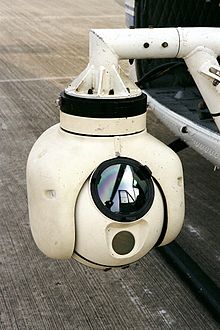 A forward looking infrared (FLIR) camera mounted on the side of an UAV similar to that from UAVs Australia.
A forward looking infrared (FLIR) camera mounted on the side of an UAV similar to that from UAVs Australia.
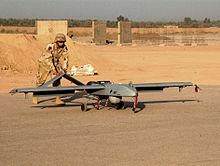 The RQ-7 Shadow is capable of delivering a 20 lb (9.1 kg) "Quick-MEDS" canister to front-line troops.
The RQ-7 Shadow is capable of delivering a 20 lb (9.1 kg) "Quick-MEDS" canister to front-line troops. IAI Heron, an Unmanned Aerial Vehicle developed by the Malat (UAV) division of Israel Aerospace Industries.
IAI Heron, an Unmanned Aerial Vehicle developed by the Malat (UAV) division of Israel Aerospace Industries.
UAVs perform a wide variety of functions. The majority of these functions are some form of remote sensing; this is central to the reconnaissance role most UAVs fulfill. Less common UAV functions include interaction and transport.
Remote sensing
UAV remote sensing functions include electromagnetic spectrum sensors, gamma ray sensors, biological sensors, and chemical sensors. A UAV's electromagnetic sensors typically include visual spectrum, infrared, or near infrared cameras as well as radar systems. Other electromagnetic wave detectors such as microwave and ultraviolet spectrum sensors may also be used, but are uncommon. Biological sensors are sensors capable of detecting the airborne presence of various microorganisms and other biological factors. Chemical sensors use laser spectroscopy to analyze the concentrations of each element in the air.
Commercial aerial surveillance
Aerial surveillance of large areas is made possible with low cost UAV systems. Surveillance applications include: livestock monitoring, wildfire mapping, pipeline security, home security, road patrol and anti-piracy. The trend for use of UAV technology in commercial aerial surveillance is expanding rapidly.
Oil, gas and mineral exploration and production
UAVs can be used to perform geophysical surveys, in particular geomagnetic surveys[29] where the processed measurements of the differential Earth's magnetic field strength are used to calculate the nature of the underlying magnetic rock structure. A knowledge of the underlying rock structure helps trained geophysicists to predict the location of mineral deposits. The production side of oil and gas exploration and production entails the monitoring of the integrity of oil and gas pipelines and related installations. For above-ground pipelines, this monitoring activity could be performed using digital cameras mounted on one, or more, UAVs.[30] The InView Unmanned Aircraft System is an example of a UAV developed for use in oil, gas and mineral exploration and production activities.
Transport
UAVs can transport goods using various means based on the configuration of the UAV itself. Most payloads are stored in an internal payload bay somewhere in the airframe. For many helicopter configurations, external payloads can be tethered to the bottom of the airframe. With fixed wing UAVs, payloads can also be attached to the airframe, but aerodynamics of the aircraft with the payload must be assessed. For such situations, payloads are often enclosed in aerodynamic pods for transport.
Scientific research
Unmanned aircraft are uniquely capable of penetrating areas which may be too dangerous for piloted craft. The National Oceanic and Atmospheric Administration (NOAA) began utilizing the Aerosonde unmanned aircraft system in 2006 as a hurricane hunter. AAI Corporation subsidiary Aerosonde Pty Ltd. of Victoria (Australia), designs and manufactures the 35-pound system, which can fly into a hurricane and communicate near-real-time data directly to the National Hurricane Center in Florida. Beyond the standard barometric pressure and temperature data typically culled from manned hurricane hunters, the Aerosonde system provides measurements far closer to the water’s surface than previously captured. Further applications for unmanned aircraft can be explored once solutions have been developed for their accommodation within national airspace, an issue currently under discussion by the Federal Aviation Administration. UAVSI, the UK manufacturer also produce a variant of their Vigilant light UAS (20 kg) designed specifically for scientific research in severe climates such as the Antarctic.
Armed attacks
MQ-1 Predator UAVs armed with Hellfire missiles are now used as platforms for hitting ground targets in sensitive areas. Armed Predators were first used in late 2001 from bases in Pakistan and Uzbekistan, mostly for hitting high profile individuals (terrorist leaders etc.) inside Afghanistan. Since then, there have been several reported cases of such attacks taking place in Pakistan, this time from Afghan-based Predators. The advantage of using an unmanned vehicle, rather than a manned aircraft, in such cases is to avoid a diplomatic embarrassment should the aircraft be shot down and the pilots captured, since the bombings took place in countries deemed friendly and without the official permission of those countries.[31][32][33][34]
A Predator based in a neighboring Arab country was used to kill suspected al-Qaeda terrorists in Yemen on November 3, 2002. This marked the first use of an armed Predator as an attack aircraft outside of a theater of war such as Afghanistan.[35]
Questions have been raised about the accuracy of the targeting of UAVs. In March 2009, The Guardian reported allegations that Israeli UAVs armed with missiles killed 48 Palestinian civilians in the Gaza Strip, including two small children in a field and a group of women and girls in an otherwise empty street.[36] In June, Human Rights Watch investigated six UAV attacks which was reported to have resulted in civilian casualties, and alleged that Israeli forces either failed to take all feasible precautions to verify that the targets were combatants, or failed to distinguish between combatants and civilians.[37][38][39] In July 2009, Brookings Institution released a report stating that in the United States-led drone attacks in Pakistan, ten civilians died for every militant killed.[40][41] S. Azmat Hassan, a former ambassador of Pakistan, said in July 2009 that American UAV attacks were turning Pakistani opinion against the United States, and that 35 or 40 such attacks only killed 8 or 9 top al-Qaeda operatives.[42]
CIA officials became concerned in 2008 that targets in Pakistan were being tipped off to pending U.S. drone strikes by Pakistani intelligence, when the U.S. requested Pakistani permission prior to launching targeted killing attacks.[43] The Bush administration therefore decided in August 2008 to abandon the practice of obtaining Pakistani government permission before launching missiles from drones, and in the next six months the CIA carried out at least 38 Predator targeted killing strikes in northwest Pakistan, compared with 10 in 2006 and 2007 combined.[43]
The Predator strikes killed at least nine senior al-Qaeda leaders, and dozens of lower-ranking operatives, depleting its operational tier in what U.S. officials described as the most serious disruption of al-Qaeda since 2001.[43] It was reported that the Predator strikes took such a toll on al-Qaeda that militants began turning violently on one another out of confusion and distrust.[43] A senior U.S. counter-terrorism official said: "They have started hunting down people who they think are responsible" for security breaches. "People are showing up dead, or disappearing."[43]
By October 2009, the CIA said they had killed more than half of the 20 most wanted al-Qaeda terrorist suspects in targeted killings.[44] By May 2010, counter-terrorism officials said that drone strikes in the Pakistani tribal areas had killed more than 500 militants since 2008, and no more than 30 (5%) nearby civilians—mainly family members who lived and traveled with the targets.[45][46] Drones linger overhead after a strike, in some cases for hours, to enable the CIA to count the bodies and determine who is a civilian.[46] A Pakistani intelligence officer gave a higher estimate of civilian casualties, saying 20% of total deaths were civilians or non-combatants.[46]
One issue with civilian casualties is the relative lack of discretion of the 100 lb (45 kg) Hellfire, which was designed to eliminate tanks and attack bunkers.[47] Smaller weapons such as the Raytheon Griffin and Small Tactical Munition are being developed as a less indiscriminate alternative,[48] and development is underway on the still smaller, US Navy-developed Spike missile.[49] The payload-limited Predator A can also be armed with six Griffin missiles, as opposed to only two of the much-heavier Hellfires. Although it may never be known how many civilians have died as a result of U.S. drone strikes in Pakistan, there are estimates of hundreds or thousands of innocent bystanders who have perished in the attacks.[50] Pakistani authorities released statistics earlier in the year indicating that between January 1, 2009 and December 31, 2009, U.S. Predator and Reaper drone strikes have killed over 700 innocent civilians. The website PakistanBodyCount.Org (by Zeeshan-ul-hassan Usmani, a Fulbright Scholar at the Florida Institute of Technology) shows 1065 civilian deaths between June 2004 to January 30, 2010 and tallying 103 drone strikes carried out by the U.S.[51] With the increase of drone strikes, according to the most recent story in The International News, January 2010 proved to be a deadly month in Pakistan with 123 innocent civilians killed. In addition,it has been reported that 160 children have died from drone attacks in Pakistan.[52] Further, over 1000 civilians have been injured.[53] This evidence counters the Obama administration's claim that 'nearly for the past year there hasn't been a single collateral death' with the drone war.[54] In the February 24, 2010 policy analysis released by the New America Foundation "The Year of the Drone" civilian fatality rate since 2004 is approximately 32%. The study shows that 114 reported drone strikes in northwest Pakistan from 2004 to present killed between 830 to 1210 individuals, of who around 550 to 850 were militants.[55]
Search and rescue
UAVs will likely play an increased role in search and rescue in the United States. This was demonstrated by the successful[says who?] use of UAVs during the 2008 hurricanes that struck Louisiana and Texas.
For example, Predators, operating between 18,000–29,000 feet above sea level, performed search and rescue and damage assessment. Payloads carried were an optical sensor (which is a daytime and infra red camera) and a synthetic aperture radar. The Predator's SAR is a sophisticated all-weather sensor capable of providing photographic-like images through clouds, rain or fog, and in daytime or nighttime conditions; all in real-time. A concept of coherent change detection in SAR images allows for exceptional search and rescue ability: photos taken before and after the storm hits are compared and a computer highlights areas of damage.[56][57]
Design and development considerations
UAV design and production is a global activity, with manufacturers all across the world. The United States and Israel were initial pioneers in this technology, and U.S. manufacturers have a market share of over 60% in 2006, with U.S. market share due to increase by 5–10% through 2016.[58] Northrop Grumman and General Atomics are the dominant manufacturers in this industry, on the strength of the Global Hawk and Predator/Mariner systems.[58] Israeli and European manufacturers form a second tier due to lower indigenous investments, and the governments of those nations have initiatives to acquire U.S. systems due to higher levels of capability.[58] European market share represented just 4% of global revenue in 2006.[58]
Development costs for American military UAVs, as with most military programs, have tended to overrun their initial estimates. This is mostly due to changes in requirements during development and a failure to leverage UAV development programs over multiple armed services. This has caused United States Navy UAV programs to increase in cost from 0% to 5% while United States Air Force UAV programs have increased from 60% to 284%.[59]
Degree of autonomy
Early UAVs used during the Vietnam War after launch captured video that was recorded to film or tape on the aircraft. These aircraft often were launched and flew either in a straight line or in preset circles collecting video until they ran out of fuel and landed. After landing, the film was recovered for analysis. Because of the simple nature of these aircraft, they were often called drones. As new radio control systems became available, UAVs were often remote controlled and the term "remotely piloted vehicle" came into vogue. Today's UAVs often combine remote control and computerized automation. More sophisticated versions may have built-in control and/or guidance systems to perform low-level human pilot duties such as speed and flight-path stabilization, and simple scripted navigation functions such as waypoint following. In news and other discussions, often the term "drone" is still mistakenly used to refer to these more sophisticated aircraft.
From this perspective, most early UAVs are not autonomous at all. In fact, the field of air-vehicle autonomy is a recently emerging field, whose economics is largely driven by the military to develop battle-ready technology. Compared to the manufacturing of UAV flight hardware, the market for autonomy technology is fairly immature and undeveloped. Because of this, autonomy has been and may continue to be the bottleneck for future UAV developments, and the overall value and rate of expansion of the future UAV market could be largely driven by advances to be made in the field of autonomy.
Autonomy technology that is important to UAV development falls under the following categories:
- Sensor fusion: Combining information from different sensors for use on board the vehicle
- Communications: Handling communication and coordination between multiple agents in the presence of incomplete and imperfect information
- Path planning: Determining an optimal path for vehicle to go while meeting certain objectives and mission constraints, such as obstacles or fuel requirements
- Trajectory Generation (sometimes called Motion planning): Determining an optimal control maneuver to take to follow a given path or to go from one location to another
- Trajectory Regulation: The specific control strategies required to constrain a vehicle within some tolerance to a trajectory
- Task Allocation and Scheduling: Determining the optimal distribution of tasks amongst a group of agents, with time and equipment constraints
- Cooperative Tactics: Formulating an optimal sequence and spatial distribution of activities between agents in order to maximize chance of success in any given mission scenario
Autonomy is commonly defined as the ability to make decisions without human intervention. To that end, the goal of autonomy is to teach machines to be "smart" and act more like humans. The keen observer may associate this with the development in the field of artificial intelligence made popular in the 1980s and 1990s such as expert systems, neural networks, machine learning, natural language processing, and vision. However, the mode of technological development in the field of autonomy has mostly followed a bottom-up approach, such as hierarchical control systems,[60] and recent advances have been largely driven by the practitioners in the field of control science, not computer science[citation needed]. Similarly, autonomy has been and probably will continue to be considered an extension of the controls field.
To some extent, the ultimate goal in the development of autonomy technology is to replace the human pilot. It remains to be seen whether future developments of autonomy technology, the perception of the technology, and most importantly, the political climate surrounding the use of such technology, will limit the development and utility of autonomy for UAV applications. Also as a result of this, synthetic vision for piloting has not caught on in the UAV arena as it did with manned aircraft. NASA utilized synthetic vision for test pilots on the HiMAT program in the early 1980s (see photo), but the advent of more autonomous UAV autopilots, greatly reduced the need for this technology.
Interoperable UAV technologies became essential as systems proved their mettle in military operations, taking on tasks too challenging or dangerous for troops. NATO addressed the need for commonality through STANAG (Standardization Agreement) 4586. According to a NATO press release, the agreement began the ratification process in 1992. Its goal was to allow allied nations to easily share information obtained from unmanned aircraft through common ground control station technology. STANAG 4586 – aircraft that adhere to this protocol are equipped to translate information into standardized message formats; likewise, information received from other compliant aircraft can be transferred into vehicle-specific messaging formats for seamless interoperability. Amendments have since been made to the original agreement, based on expert feedback from the field and an industry panel known as the Custodian Support Team. Edition Two of STANAG 4586 is currently under review. There are many systems available today that are developed in accordance with STANAG 4586, including products by industry leaders such as AAI Corporation, CDL Systems, and Raytheon, all three of which are members of the Custodian Support Team for this protocol.
Endurance
Because UAVs are not burdened with the physiological limitations of human pilots, they can be designed for maximized on-station times. The maximum flight duration of unmanned, aerial vehicles varies widely. Internal-combustion-engine aircraft endurance depends strongly on the percentage of fuel burned as a fraction of total weight (the Breguet endurance equation), and so is largely independent of aircraft size. Solar-electric UAVs hold potential for unlimited flight, a concept originally championed by the AstroFlight Sunrise in 1974[61][62][63][64] and the much later Aerovironment Helios Prototype, which was destroyed in a 2003 crash.
Electric UAVs kept aloft indefinitely by laser power-beaming[65] technology represent another proposed solution to the endurance challenge. This approach is advocated by Jordin Kare and Thomas Nugent.
One of the major problems with UAVs is the lack of inflight refueling capability. Currently the US Air Force is promoting research that should end in an inflight UAV refueling capability. The first UAV-UAV refueling flights are expected sometime during the first half of 2012.[66]
One of the uses for a high endurance UAV would be to "stare" at the battlefield for a long period of time to produce a record of events that could then be played backwards to track where improvised explosive devices (IEDs) came from. Air Force Chief of Staff John P. Jumper started a program to create these persistent UAVs, but this was stopped once he was replaced.[67]
The Defense Advanced Research Projects Agency (DARPA) is to sign a contract on building an UAV which should have an enormous endurance capability of about 5 years. The project is entitled "Vulture" and a September 15, 2010 news release indicated DARPA’s Vulture Program Enters Phase II.[68] The developers are certain neither on the design of the UAV nor on what fuel it should run to be able to stay in air without any maintenance for such a long period of time.[69]
Notable high endurance flights UAV Flight time Date Notes QinetiQ Zephyr Solar Electric 336 hours 22 minutes 9–23 July 2010 [70] QinetiQ Zephyr Solar Electric 82 hours 37 minutes 28–31 July 2008 [71] Boeing Condor 58 hours 11 minutes 1989 The aircraft is currently in the Hiller Aviation Museum, CA. QinetiQ Zephyr Solar Electric 54 hours September 2007 [73][74] IAI Heron 52 hours ? [75][76] AC Propulsion Solar Electric 48 hours 11 minutes June 3, 2005 [77] MQ-1 Predator 40 hours 5 minutes ? [78] GNAT-750 40 hours 1992 [79][80] TAM-5 38 hours 52 minutes August 11, 2003 Smallest UAV to cross the Atlantic Aerosonde 38 hours 48 minutes May 3, 2006 [83] Vanguard Defense Industries 2 hours 55 minutes 11 February 2011 VTOL platform carrying a 18 lb payload.[84] TAI Anka 24 hours 30 December 2010 [85] Existing UAV systems
UAVs have been developed and deployed by many countries around the world. For a list of models by country, see : List of unmanned aerial vehicles. The use of unmanned aerial systems, however, is not limited to state powers: non-state actors can also build, buy and operate these combat vehicles.[86] Hezbollah used a drone during the 2006 Lebanon War, and in 2001 Al-Qaeda reportedly explored using drones to attack a conference of international leaders.[86]
The export of UAVs or technology capable of carrying a 500 kg payload at least 300 km is restricted in many countries by the Missile Technology Control Regime. At the center of the American military's continued UAV research is the MQ-X, which builds upon the capabilities of the Reaper and Predator drones. As currently conceived, the MQ-X would be a stealthier and faster fighter-plane sized UAV capable of any number of missions: high-performance surveillance; attack options, including retractable cannons and bomb or missile payloads; and cargo capacity.[87]
China has exhibited some UAV designs, but its ability to operate them is limited by the lack of high endurance domestic engines, satellite infrastructure and operational experience.[88]
Historical events involving UAVs
- During the Persian Gulf War, Iraqi Army forces surrendered to the UAVs of the USS Wisconsin.[89][90]
- In October 2002, a few days before the U.S. Senate vote on the Authorization for Use of Military Force Against Iraq Resolution, about 75 senators were told in closed session that Saddam Hussein had the means of delivering biological and chemical weapons of mass destruction by UAV drones that could be launched from ships off the Atlantic coast to attack U.S. eastern seaboard cities. Colin Powell suggested in his presentation to the United Nations that they had been transported out of Iraq and could be launched against the U.S.[91] It was later revealed that Iraq's UAV fleet consisted of only a few outdated Czech training drones.[92] At the time, there was a vigorous dispute within the intelligence community as to whether CIA's conclusions about Iraqi UAVs were accurate. The U.S. Air Force agency most familiar with UAVs denied outright that Iraq possessed any offensive UAV capability.[93]
- In December 2002, the first ever dogfight involving a UAV occurred when an Iraqi MiG-25 and a U.S. RQ-1 Predator fired missiles at each other. The MiG's missile destroyed the Predator.[94]
UAVs in popular culture
- UAVs have been used in many episodes of the science-fiction television series Stargate SG-1, and a sentient unmanned combat air vehicle (UCAV) was a central figure in the action film Stealth. UAVs are also used in computer and video games such as F.E.A.R., inFamous, Tom Clancy's Ghost Recon, and the popular Call of Duty: Modern Warfare, Battlefield 2 and Battlefield: Bad Company franchises.[95] A more futuristic and fictional example of a combat UAV is a Man-hack featured in Half-Life2 game series. A manhack is a UAV roughly the size of a bowling ball and uses onboard artificial intelligence combined with sharprotating blades to sustain flight and inflict severe lacerations to its targets. It is designed to be mass produced and deployed either by individual soldiers or in very large numbers to saturate a hostile area.[96]
See also
- Aerobot
- Energy harvesting
- List of unmanned aerial vehicles
- Metaplane
- Micro air vehicle
- Miniature UAV
- Missile Technology Control Regime
- Nano Hummingbird
- Radio-controlled aircraft
- Targeted killing
- Historic
- Facilities, units and programs
- 82d Aerial Targets Squadron
- International Aerial Robotics Competition
- ParcAberporth, Royal Air Force facility
- UAV Battlelab, U.S. Air Force facility
- Other types of unmanned vehicles
- Intelligence
- Intelligence collection management
- Intelligence, Surveillance, Target Acquisition and Reconnaissance
- Measurement and signature intelligence
References
- ^ The Free Dictionary, accessed 19 November 2010
- ^ a b Pir Zubair Shah, "Pakistan Says U.S. Drone Kills 13", New York Times, June 18, 2009.
- ^ David Axe, "Strategist: Killer Drones Level Extremists’ Advantage", Wired, June 17, 2009.
- ^ a b c Taylor, A. J. P. Jane's Book of Remotely Piloted Vehicles.
- ^ Dempsey, Martin E. Eyes of the Army – U.S. Army Roadmap for Unmanned Aircraft Systems 2010–2035 Size: 9MB United States Army, 9 April 2010. Accessed: 6 March 2011.
- ^ Wagner p. xi
- ^ Wagner p. xi, ,xii
- ^ Wagner p. xii
- ^ Wagner p. 79
- ^ Wagner p. 78 & 79 photos
- ^ Wagner p. 202
- ^ Wagner p. 200 & 212
- ^ a b Wagner p. 208
- ^ "A Brief History of UAVs". http://www.howstuffworks.com/reaper1.htm.
- ^ "Russia Buys A Bunch Of Israeli UAVs". http://www.strategypage.com/htmw/htairfo/articles/20090409.aspx.
- ^ Azoulai, Yuval (October 24, 2011). "Unmanned combat vehicles shaping future warfare". Globes. http://www.globes.co.il/serveen/globes/docview.asp?did=1000691790.
- ^ Levinson, Charles (January 13, 2010). "Israeli Robots Remake Battlefield". The Wall Street Journal. p. A10. http://online.wsj.com/article/SB126325146524725387.html. Retrieved January 13, 2010.
- ^ http://www.modelaircraft.org/files/105.pdf
- ^ http://www.fbo.gov/servlet/Documents/R/1610757
- ^ History of Unmanned Aerial Vehicles
- ^ Comparison of USAF Tier II, II+ and III- systems
- ^ http://www.edwards.af.mil/articles98/docs_html/splash/may98/cover/Tier.htm USAF Tier system
- ^ http://www.avinc.com/pr_detail.asp?ID=68
- ^ USMC powerpoint presentation of tier system
- ^ Detailed description of USMC tier system
- ^ a b http://www.defensetech.org/archives/cat_fcs_watch.html
- ^ http://www.acq.osd.mil/usd/Roadmap%20Final2.pdf#search=%22Dod%20UAS%20Roadmap%202005%22
- ^ "Drone aircraft in a stepped-up war in Afghanistan and Pakistan", Iran design uav engine WWW.UAV.IR
- ^ http://www.universalwing.com/technology/our-uav
- ^ http://www.barnardmicrosystems.com/L4E_inview_papers.htm#Paper_1
- ^ Fox News
- ^ Defense Industry Daily
- ^ MSNBC
- ^ Globe and Mail
- ^ Federation of American Scientists
- ^ The Guardian, March 23, 2009. "Cut to pieces: the Palestinian family drinking tea in their courtyard: Israeli unmanned aerial vehicles—the dreaded drones—caused at least 48 deaths in Gaza during the 23-day offensive." Retrieved on August 3, 2009.
- ^ "Precisely Wrong: Gaza Civilians Killed by Israeli Drone-Launched Missiles", Human Rights Watch, June 30, 2009.
- ^ "Report: IDF used RPV fire to target civilians", YNET, June 30, 2009
- ^ "Israel/Gaza: Civilians must not be targets: Disregard for Civilians Underlies Current Escalation". Human Rights Watch. December 30, 2008. http://www.hrw.org/en/news/2008/12/30/israelgaza-civilians-must-not-be-targets. Retrieved August 3, 2009.
- ^ Drones kill 10 civilians for one militant: US report, Dawn (newspaper), 2009-07-21
- ^ "Do Targeted Killings Work?", Brookings Institution, 2009-07-14
- ^ Newsweek, July 8, 2009. Anita Kirpalani, "Drone On. Q&A: A former Pakistani diplomat says America's most useful weapon is hurting the cause in his country." Retrieved on August 3, 2009.
- ^ a b c d e Greg Miller (March 22, 2009). "U.S. missile strikes said to take heavy toll on Al Qaeda". Los Angeles Times. http://articles.latimes.com/2009/mar/22/world/fg-pakistan-predator22. Retrieved May 19, 2010.
- ^ Terry Gross, host (October 21, 2009). "Jane Mayer: The Risks Of A Remote-Controlled War". NPR. http://www.npr.org/templates/transcript/transcript.php?storyId=113978637. Retrieved May 20, 2010.
- ^ "U.S. Approval of Killing of Cleric Causes Unease", Scott Shane, The New York Times, May 13, 2010. Retrieved October 17, 2010.
- ^ a b c Entous, Adam (May 19, 2010). "How the White House learned to love the drone". Reuters. http://uk.reuters.com/article/idUKTRE64H5U720100519?pageNumber=3. Retrieved October 17, 2010.
- ^ Smaller, Lighter, Cheaper William Matthew; Defense News; May 31, 2010
- ^ "AUVSI: Raytheon designing UAV-specific weapons". http://www.flightglobal.com/articles/2010/08/26/346610/auvsi-raytheon-designing-uav-specific-weapons.html. Retrieved December 19, 2010.
- ^ Efforts Are Underway to Arm Small UAVs Aviation Week; Oct 17, 2008
- ^ Peter Bergen and Katherine Tiedemann (October 18, 2009). "Revenge of the Drones". New America Foundation. http://www.newamerica.net/publications/policy/revenge_of_the_drones. Retrieved 2011-9-20.
- ^ http://www.pakistanbodycount.org/
- ^ Woods, Chris (August 11, 2011). "Over 160 children reported among drone deaths". The Bureau of Investigative Journalism. http://www.thebureauinvestigates.com/2011/08/11/more-than-160-children-killed-in-us-strikes/. Retrieved 2011-9-20.
- ^ Woods, Chris (August 10, 2011). "You cannot call me lucky - drones injure over 1,000". The Bureau of Investigative Journalism. http://www.thebureauinvestigates.com/2011/08/10/one-thousand-drone-injuries-are-they-truly-lucky-o/. Retrieved 2011-9-20.
- ^ Muhammad Idrees Ahmad (July 30, 2011). "Fighting Back against the CIA drone war". Al Jazeera. http://english.aljazeera.net/indepth/opinion/2011/07/201172612395401691.html. Retrieved 2011-9-20.
- ^ Peter Bergen and Katherine Tiedemann. "2004-2011". New America Foundation. http://counterterrorism.newamerica.net/drones. Retrieved 2011-9-10.
- ^ AP Texas News
- ^ 2008 Search and Rescue Missions
- ^ a b c d "UAVs on the Rise." Dickerson, L. Aviation Week & Space Technology. January 15, 2007.
- ^ Defense Acquisitions: Opportunities Exist to Achieve Greater Commonality and Efficiencies among Unmanned Aircraft Systems
- ^ Shim, D. H, Kim, H. J., Sastry, S., Hierarchical Control System Synthesis for Rotorcraft-based Unmanned Aerial Vehicles.
- ^ Boucher, Roland (undated). "Project Sunrise pg 1". http://www.projectsunrise.info/First_Solar_Powered_Aircraft.html. Retrieved September 23, 2009.
- ^ Boucher, Roland (undated). "Project Sunrise pg 13". http://www.projectsunrise.info/Flight__Tests.html. Retrieved September 23, 2009.
- ^ Newcome, Laurence R. (2004). Unmanned aviation: a brief history of unmanned aerial vehicles. http://books.google.com/books?isbn=1563476444. Retrieved September 23, 2009.
- ^ Curry, Marty (March 2008). "Solar-Power Research and Dryden". http://www.nasa.gov/centers/dryden/news/FactSheets/FS-054-DFRC.html. Retrieved September 15, 2009.
- ^ "Wireless Power for UAVs". 2010. http://lasermotive.com/wp-content/uploads/2010/04/Wireless-Power-for-UAVs-March2010.pdf.
- ^ Northrop Grumman Planning First UAV-to-UAV Aerial Refueling
- ^ counter_ied_backtracking.mpg
- ^ http://www.darpa.mil/news/2010/NewsReleaseVultureII.pdf
- ^ Vulture – The Unmanned Aircraft Able to Stay in the Air for 5 Years
- ^ QinetiQ press release
- ^ QinetiQ press release
- ^ Hiller Aviation Museum reference to the flight
- ^ QinetiQ press release
- ^ New Scientist article
- ^ "Spies That Fly: Time Line of UAVs". PBS NOVA. http://www.pbs.org/wgbh/nova/spiesfly/uavs.html.
- ^ "Heron 1". Israel Aerospace Industries. http://www.iai.co.il/Default.aspx?docID=16382&FolderID=18900&lang=en.
- ^ AC Propulsion release describing the flight
- ^ UAV Forum reference Federation of American Scientists reference
- ^ Directory of US Military Rockets and Missiles reference to the flight
- ^ UAV Endurance Prehistory reference
- ^ TAM Homepage
- ^ TAM-5 FAQ page
- ^ Aerosonde release on the flight
- ^ http://www.aviationweek.com/media/pdf/spec_04_uav.pdf
- ^ http://www.zaman.com.tr/haber.do?haberno=1074255&title=insansiz-hava-araci-gelistirme-projesi-imzalandi
- ^ a b Singer, Peter W. "A Revolution Once More: Unmanned Systems and the Middle East", The Brookings Institution, November 2009.
- ^ Singer, Peter W. "How the US Military Can Win the Robotic Revolution", The Brookings Institution, 17 May 2010.
- ^ Axe, David. "US Drones Trump China Theatrics" The Diplomat, 7 February 2011.
- ^ Federation of American Scientists. Pioneer Short Range (SR) UAV. Accessed November 26, 2006.
- ^ National Air and Space Museum, Smithsonian Institution. Pioneer RQ-2A September 14, 2001. Accessed November 26, 2006.
- ^ Senator Bill Nelson (January 28, 2004) "New Information on Iraq's Possession of Weapons of Mass Destruction", Congressional Record
- ^ Lowe, C. (December 16, 2003) "Senator: White House Warned of UAV Attack," Defense Tech
- ^ Hammond, J. (November 14, 2005) "The U.S. 'intelligence failure' and Iraq's UAVs" The Yirmeyahu Review
- ^ Pilotless Warriors Soar To Success, www.cbsnews.com, April 25, 2004. Accessed April 21, 2007.
- ^ US Navy UAVs in Action, Neubeck, (Squadron/Signal Publications 2010)
- ^ http://half-life.wikia.com/wiki/Manhack
- Wagner, William. Lightning Bugs and other Reconnaissance Drones; The can-do story of Ryan's unmanned spy planes. 1982, Armed Forces Journal International, in cooperation with Aero Publishers, Inc.
External links
- VTOL UAVs
- History of WWI-era UAVs – Remote Piloted Aerial Vehicles : The 'Aerial Target' and 'Aerial Torpedo' in the USA
- Defense Update reports about UAV employment in Persistent Surveillance
Mobile robots Ground OtherUnderwater Unmanned underwater vehicle (UUV) · Autonomous underwater vehicle (AUV) · Intervention AUV (I-AUV) · Remotely operated underwater vehicle (ROUV) · Underwater gliderSurface Aerial Unmanned aerial vehicle (UAV) · Unmanned aircraft system · Aerobot · Helicam · Unmanned combat air vehicle (UCAV) · Unmanned Aircraft · OrnithopterSpace Other Domestic · Military · Rescue · Medical · Disability · Agricultural · BEAM robotics · Microbotics · NanoroboticsSee also: Unmanned vehicle · Robotics · Robot locomotion · Autonomous robot · Autonomous logistics · Radio-controlled model · Remote control vehicle · Remote-controlled animal · Categories: Radio control · Unmanned vehiclesRobotics (outline) Main articles Outline of robotics · Glossary of robotics · Index of robotics articles · History of robots · Robotics worldwide · Robot Hall of Fame · Roboethics · Robotic laws · Human-robot interaction · AI Competitions · Future of roboticsRobots Humanoids · Androids · Biomorphic · Hexapods · Industrial · Articulated · Domestic · Entertainment · Military · Medical · Service · Disability · Agricultural · Food service · BEAM robotics · Microbotics · Nanorobotics • List of robots · Fictional robotsRobot classification Robot locomotion Wheels · Tracks · Walking · Running · Swimming · Climbing · Hopping · Metachronal motion · Crawling · BrachiatingRobot navigation Robot research Roboticist · Areas · Evolutionary · Kits · Simulator · Suite · Open-source · Software · Adaptable · Developmental · Paradigms · UbiquitousLists relating to aviation General Aircraft (manufacturers) · Aircraft engines (manufacturers) · Airlines (defunct) · Airports · Civil authorities · Museums · Registration prefixes · Rotorcraft (manufacturers) · TimelineMilitary Accidents/incidents Records Categories:- Military terminology
- Signals intelligence
- Unmanned aerial vehicles
Wikimedia Foundation. 2010.

